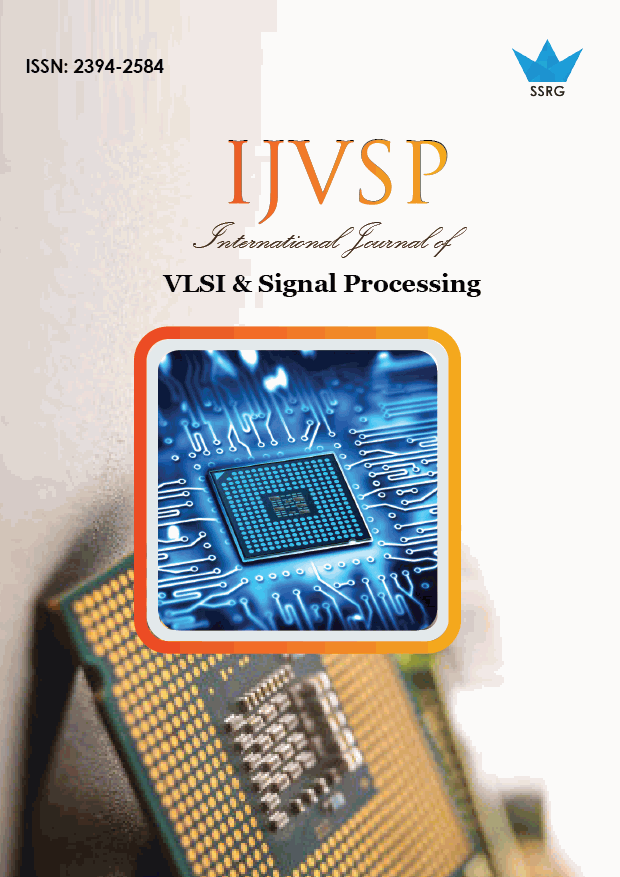Energy Harvesting from Piezoelectric Material using Human Motion

| International Journal of VLSI & Signal Processing |
| © 2019 by SSRG - IJVSP Journal |
| Volume 6 Issue 2 |
| Year of Publication : 2019 |
| Authors : Mr. Abhinav V. Deshpande |
How to Cite?
Mr. Abhinav V. Deshpande, "Energy Harvesting from Piezoelectric Material using Human Motion," SSRG International Journal of VLSI & Signal Processing, vol. 6, no. 2, pp. 5-8, 2019. Crossref, https://doi.org/10.14445/23942584/IJVSP-V6I2P102
Abstract:
Energy is the input to drive and improve the life cycle. It is the gift of the nature to the human beings. The consumption of the energy shows the progress of the human being. Energy is present in different forms. In this research paper, we intend to explain the process of energy harvesting from piezoelectric material by using human motion. The concept of energy harvesting, which is a process of capturing the ambient waste energy and converting it into usable electricity, the extremely low power electrical and mechanical devices such as micro electromechanical systems (MEMS) make such renewable power sources very attractive. In this design, we use the piezoelectric sensors in order to change the pressure so that an electrical output could be generated. The output of the piezoelectric sensor is given to the boost converter. The MOSFET in the boost converter amplifies the voltage. The microcontroller uses control in the MOSFET driver circuit which in turn controls the microcontroller.
Keywords:
Microcontroller, Piezoelectric Sensor, DC to DC Converter, MOSFET
References:
[1] S. P. Beeby, M. J. Tudor and N. M. White, “Energy Harvesting Vibration Sources for Microsystems Applications”, Measurement Science and Technology, Volume 17, pp. 175-195, 2006.
[2] H. R. Trankler and O. Kanoun, “Recent Advances in Sensor Technology”, Budapest, 2001, pp. 309-316.
[3] S. Roundy, P. K. Wright and J. Rabaey, “A Study of Low Level Vibrations as a Power Source for Wireless Sensor Nodes”, Computer Communications, Volume 26, pp. 1131-1144, 2003.
[4] S. Roundy, E. S. Leland, J. Baker, E. Carleton, E. Reilly, E. Lai, B. Otis, J. M. Rabaey, P. K. Wright and V. Sundararajan, “Improving Power Output for Vibration-Based Energy Scavengers”, IEEE Pervasive Computing, Volume 4, pp. 28-36, 2005.
[5] Y. B. Jeon, R. Sood, J. H. Jeong and S. G. Kim, “MEMS Power Generator with Transverse Mode Thin Film PZT”, Sensors and Actuators, A: Physical, Volume 122, pp. 16-22, 2005.
[6] Eichhorn C. et. Al., “A Piezoelectric Harvester with an Integrated Frequency-Tuning Mechanism”, Technical Digest Power MEMS 2009 (Washington, USA, December 01-04, 2009), pp. 45-48.
[7] Alireza Khaligh, Peng Zeng and Cong Zheng, “Kinetic Energy Harvesting using Piezoelectric and Electromagnetic Technologies-State of the Art”, IEEE Transactions on Industrial Electronics, Volume 57, No. 3, March 2010.
[8] J. F. Antaki, G. E. Bertocci, E. C. Green, A. Nadeem, T. Rintoul, R. L. Kormos and B. P. Griffith, “Gait-Powered Autologous Battery Charging System for Artificial Organs”, ASAIO Journal, Volume 41, pp. 588-595, 1995.
[9] Piezo Technologies Materials Specifications
[10] Sodano, H. A. Magliula, E. A. Park G. and Inman D. J., 2002, “Electric Power Generation from Piezoelectric Materials”, in the Proceedings of the 13th International Conference on Adaptive Structures and Technologies (2002).
[11] Gautschi G. (2002), Piezoelectric Sensorics: Force, Strain, Pressure, Acceleration and Acoustic Emission Sensors, Materials and Amplifiers, Springer.
[12] M. Birkholz (1995), “Crystal-Field Induced Dipoles in Heteropolar Crystals-II, Physical Significance”, Z. Phys. B 96: 333-340 Bibcode 1995Z PhyB..96..333Bdoi: 10.1007/BF01313055.http://www.mariobirkholz.de/ZPB1995b.pdf
[13] E. Lefeuvre, A. Badel, C. Richard, L. Petit and D. Guyomar, “A Comparison Between Several Vibrattion-Powered Piezoelectric Generators for Standalone Systems”, Sensor Actuators A, Volume 126, No. 2, pp. 405-416, 2006.

 10.14445/23942584/IJVSP-V6I2P102
10.14445/23942584/IJVSP-V6I2P102